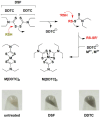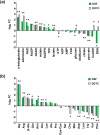Disulfiram induces redox imbalance and perturbations in central glucose catabolism and metal homeostasis to inhibit the growth of Staphylococcus aureus
- PMID: 40325037
- PMCID: PMC12053631
- DOI: 10.1038/s41598-025-00078-3
Disulfiram induces redox imbalance and perturbations in central glucose catabolism and metal homeostasis to inhibit the growth of Staphylococcus aureus
Abstract
Disulfiram (Antabuse®) is a prescription alcohol sobriety aid that has shown repurposing potential as an antibacterial drug for infections due to Gram-positive bacteria. In this investigation, we sought to define the principal mechanisms that disulfiram operates as a growth inhibitor of Staphylococcus aureus using differential transcriptomic, metabolomic, bioenergetic, and phenotypic growth analyses. The RNA-seq transcriptome analysis revealed that disulfiram induces oxidative stress, redox imbalance, metal acquisition, and the biosynthesis of pantothenate, coenzyme A, thiamine, menaquinone, siderophores/metallophores, and bacillithiol. The metabolomic analysis indicated that disulfiram depletes coenzyme A and attenuates the catabolism of glucose, pyruvate, and NADH. Conversely, disulfiram appeared to up-regulate arginine catabolism for ATP production and accelerate citrate consumption that was attributed to induction of siderophore biosynthesis (i.e., staphyloferrin). The bioenergetic studies further revealed that the primary metabolite of disulfiram (i.e., diethyldithiocarbamate) is likely involved in the mechanism of action as an inhibitor of oxidative phosphorylation and chelating agent of iron and other metals. In the final analysis, disulfiram inhibits the growth of S. aureus by inducing perturbations in central glucose catabolism and redox imbalance (e.g., oxidative stress). Moreover, the chelation of metal ions and antagonism of the respiratory chain by diethyldithiocarbamate are believed to contribute to the inhibition of cell replication.
© 2025. The Author(s).
Conflict of interest statement
Declarations. Competing interests: The authors declare no competing interests.
Figures






Similar articles
-
The nucleobase analog 4-thiouracil hijacks the pyrimidine salvage pathway to inhibit Staphylococcus aureus growth.Microbiol Spectr. 2025 Jul;13(7):e0064025. doi: 10.1128/spectrum.00640-25. Epub 2025 May 27. Microbiol Spectr. 2025. PMID: 40422278 Free PMC article.
-
Resisting the resistance: the antimicrobial peptide DGL13K selects for small colony variants of Staphylococcus aureus that show increased resistance to its stereoisomer LGL13K, but not to DGL13K.J Bacteriol. 2025 Jun 24;207(6):e0050524. doi: 10.1128/jb.00505-24. Epub 2025 Jun 4. J Bacteriol. 2025. PMID: 40464584 Free PMC article.
-
Systematic review of disulfiram as an antibacterial agent: what is the evidence?Int J Antimicrob Agents. 2022 May;59(5):106578. doi: 10.1016/j.ijantimicag.2022.106578. Epub 2022 Apr 1. Int J Antimicrob Agents. 2022. PMID: 35367599
-
Targeting the MEK1/2 pathway to combat Staphylococcus aureus infection and inflammation in cystic fibrosis.mBio. 2025 Jul 9;16(7):e0077525. doi: 10.1128/mbio.00775-25. Epub 2025 May 27. mBio. 2025. PMID: 40422262 Free PMC article.
-
Biomarkers as point-of-care tests to guide prescription of antibiotics in people with acute respiratory infections in primary care.Cochrane Database Syst Rev. 2022 Oct 17;10(10):CD010130. doi: 10.1002/14651858.CD010130.pub3. Cochrane Database Syst Rev. 2022. PMID: 36250577 Free PMC article.
References
-
- Reus, V. I. et al. The American psychiatric association practice guideline for the pharmacological treatment of patients with alcohol use disorder. Am. J. Psychiatry. 175 (1), 86–90. 10.1176/appi.ajp.2017.1750101 (2018). - PubMed
-
- Johansson, B. A review of the pharmacokinetics and pharmacodynamics of disulfiram and its metabolites. Acta Psychiatr. Scand. Suppl. 369, 15–26. 10.1111/j.1600-0447.1992.tb03310.x (1992). - PubMed
-
- Lipsky, J. J., Shen, M. L. & Naylor, S. In vivo inhibition of aldehyde dehydrogenase by disulfiram. Chem. Biol. Interact. 130–132 (1–3), 93–102. 10.1016/s0009-2797(00)00225-8 (2001). - PubMed
-
- Hu, P., Jin, L. & Baillie, T. A. Studies on the metabolic activation of disulfiram in rat. Evidence for electrophilic S-oxygenated metabolites as inhibitors of aldehyde dehydrogenase and precursors of urinary N-acetylcysteine conjugates. J. Pharmacol. Exp. Ther.281 (2), 611–617 (1997). PMID: 9152363. - PubMed
MeSH terms
Substances
Grants and funding
LinkOut - more resources
Full Text Sources
Medical

